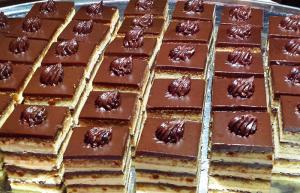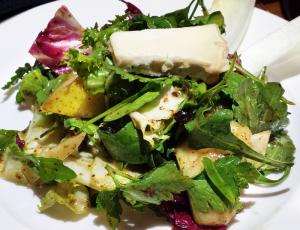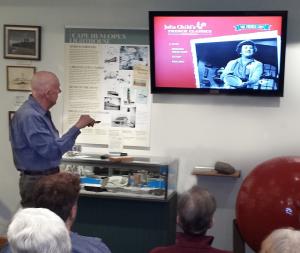Creative dining owes its cachet to pioneers like Julia Child
The words “progressive dinner” can strike fear into the heart of pretty much anybody who reached early adulthood in the semi-trendy ‘70s. These debacles-in-the-making always started off with the best of intentions: Everyone gathered at the first house, had a sip and a bite of this and/or that, then drove to house number two. More sips. More bites. More sips. This is where things began to unravel, because although society had not yet cracked down on synchronized drinking and driving, low-level skirmishes over designated-driver duties would inevitably erupt.
The arrival at house number three triggered a spiral into anarchy. Stomachs filled faster because of the interval between meals, so the host would end up in a snit as already satiated diners eschewed the feast in favor of the couch and football. It was a pretty good bet that this particular group would probably never meet again, at least not in that form.
But imagine if all three venues were within about 100 feet of one another, thus eliminating the death-defying drive. Lo and behold, that’s exactly what happened last week at Root Gourmet, Touch of Italy and Nage Bistro. Tasty bites were passed around and wines were poured at Root Gourmet as GM Rich Garrahan kept diners’ plates full of cheeses, charcuterie, empanadas and roasted shrimp. After about 45 minutes we were rousted out to Touch of Italy, about 13.2 steps to the north. Smiling GM Sal Cascone (who had obviously witnessed us putting away the champagne) kindly held the door as we were ushered into the bustling salumeria/pasticceria/trattoria.
Touch of Italy’s just-baked bread was passed around with olive oil and grated parmesan (Italian butter!) just before heaping platters of Nonna’s Sunday Supper were presented. Italian sausage and short ribs from Sal Biancardi’s meat market in The Bronx, Touch of Italy’s own braciole and Mama’s Meatballs were piled high on a bed of cavatelli in gravy. In true Italian tradition, the salad that followed was refreshingly light with pears, crisp greens, sharp Italian cheese and brightly acidic champagne vinaigrette.
Nage outdid itself in the dessert department. As if Veuve Clicquot champagne, cherry profiteroles, blueberry macaroons and layer cake were not enough, GM Mark Harrison acknowledged Fat Tuesday with a traditional king cake. I’m not sure who found the baby - I’ll have to poll the local dentists to find out. And other than the sugar high, we all made it home in proper legal fashion.
The mysteries of the kitchen and professional cooking are familiar to many, thanks to Food Network and Cooking Channel. But much of today’s fascination with all things culinary can be traced back to the legendary Julia Child. The networks, publishers, websites, retailers and restaurant columnists that followed have her to thank for engaging the public in the art and science of cooking.
To mark the denouement of Rehoboth Beach Museum’s yearlong Beach Eats! exhibit, Society Director Nancy Alexander, Program Assistant Barb Smith and Rehoboth Beach Historical Society Secretary Hoyte Decker played host to local foodies last Friday for an exclusive screening of "The French Chef." The show was created and hosted by Julia Child, and produced and broadcast by WGBH, the public television station in Boston, Mass., from 1963 to 1973. Not only was it one of the first cooking shows on television, but it was also the first to light up the museum’s new wall-mounted flat-screen TV.
The energetic and affable Decker provided a few culinary demonstrations of his own (including an ingenious way to remove the skin from garlic), and then we watched the very tall, very talented and always out-of-breath Julia prepare her famous French onion soup and a light-as-air chocolate mousse. Not unlike "I Love Lucy," these early black-and-white episodes were shot using multiple cameras. The difference was that Lucy was shot on film, which allowed for creative editing after the show was performed. "The French Chef," however, was shot using television cameras, so what the viewers saw on the screen was determined in real time as the director switched among the cameras as Julia was cooking. So retakes and edits were few and far between. When she spilled the cognac, well … she spilled the cognac for all to see. If an unruly onion eluded her knife by skittering off the cutting board, we witnessed her deft moves to corral the little fugitive.
In both episodes, it was obvious that she had finished earlier than expected, and she responded to off-camera “stretch” signals by filling her half-hour any way she could. Digital time manipulation was at least 40 years in the future, so the allotted minutes had to be filled - one way or another. She accomplished it with grace and aplomb.
I remember how impressed I was the first time I observed her skills and educated patter as she effortlessly whipped up these dishes (well, she made it look effortless). This pioneering woman had no idea of how many things - perhaps even columns such as this one - might never have existed without her groundbreaking presentations and her love of French cooking. So, in tribute to Julia Child, this week I’ll top things off the way she topped off each of her shows: “Bon appétit!”
























































